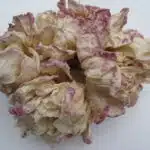As delicate and fragile as a rose, yet hardy enough to thrive without much fuss – the moss rose is truly a wonder of nature. With its vibrant and cheerful petals, it has the power to bring a smile even on the most stressful days. But don’t let its beauty fool you; this plant requires proper care if it is to reach its full potential. To help us understand what it takes to help this flower reach its full glory, let’s take a closer look at how to care for and grow the moss rose.
When you think of flowers, one of the first that come to mind are roses. Yet, few know about their cousin – the moss rose. This beautiful flower can be found in many gardens around the world with its vibrant pink and yellow petals bringing a cheerful atmosphere wherever it goes. It’s no wonder why these plants are so popular; they are incredibly easy to care for and require only minimal attention for them to stay healthy and happy throughout their lifetime.
For those seeking an effortless way to add color and cheerfulness into their garden or home, then look no further than the moss rose. With proper care and just a little bit of knowledge, anyone can learn how to enjoy this wonderful flower’s presence all year round! In this article, we will discuss everything you need to know about growing and taking care of your own moss roses so you can enjoy their company for years to come!
What Is A Moss Rose?
The moss rose is a sight to behold. Its petals, soft as a blanket of snow, are hued in delicate shades of pink and yellow. The foliage is compact and succulent, with its bright green leaves that appear to be sprinkled with velvety dust. It’s no wonder why this beautiful flower has been described as a miniature rose!
With its low-maintenance requirements and hardy nature, the Moss Rose is perfect for those new to gardening. This blooming beauty will thrive in any season if given proper care. As long as you remember to water it regularly, provide enough sunlight and plant it in nutrient-rich soil, this perennial will show off its colors for many years to come.
Besides being a stunning addition to any garden or patio, the Moss Rose can also be used in more creative ways. From beautiful bouquets to gorgeous flower crowns, there are plenty of ideas for showcasing this amazing bloom! With so much potential and charm, the Moss Rose should be at the top of your list when looking for flowers for your next project.
Where Do Moss Roses Grow?
Moss roses are the crown jewels of gardens, adding a touch of sophistication with their delicate petals and vibrant colors. As they spread cheer throughout any outdoor space, it’s important to know where these flowers thrive best. Here are three tips on where moss roses like to grow:
- Moss roses love full sun exposure, so anywhere that gets at least 6 hours of sunlight per day is ideal.
- They also like warm climates, as long as there’s good drainage in the soil.
- Lastly, moss roses prefer to be planted in areas that have some protection from the wind.
Since moss roses need plenty of direct sunlight and warmth to succeed, the best places for them are typically near south-facing walls or along the edges of patios and terraces. This way, they can take advantage of the reflected heat from nearby surfaces while still getting plenty of direct sun exposure. If you’re looking for an area with more protection from wind and rain, try planting your moss roses next to a fence or trellis since these provide shelter and support for their stems.
Wherever you decide to plant your moss roses, just make sure it provides enough access to sunlight and minimal exposure to harsh winds – then sit back and watch them blossom! With proper care, these low-maintenance blooms will reward you with cheerful color all season long.
How To Plant Moss Roses
Moss Roses are an attractive, easy to grow flower that can provide a stunning addition to any garden. With their beautiful petals, they are sure to draw the eye and bring a touch of elegance to any setting. Planting moss roses is a simple process that anyone can do, so let’s take a closer look at how you can get your own growing!
Explosively, it’s time to get started with planting your moss roses. First off, you’ll need to choose a location for them that gets plenty of sun and has good drainage. Once you’ve found the perfect spot and prepared the soil, it’s time to plant your moss roses. You should start by digging several holes about four inches deep for each plant and then place the roots in the hole before covering them with soil. Water your plants thoroughly after planting and make sure they receive plenty of sunlight throughout the day.
Caring for your newly planted moss roses is just as important as planting them correctly! Make sure they get enough water but be careful not to overwater them as this can lead to root rot. Fertilizing every few weeks can help keep your plants healthy and help them grow faster. Additionally, deadheading spent blossoms will encourage more blooms over the season and keep them looking their best. With just these few steps, you’ll have beautiful blooms in no time!
Now that we’ve covered planting and caring for moss roses, let’s move on to discussing how best to enjoy these delightful flowers in our gardens…
Caring For Moss Roses
Caring for moss roses is the key to keeping them blooming and healthy. A few essential tips can help you get the most out of these beautiful flowers. Firstly, it’s important to give them plenty of sun. Place your moss rose in a spot that receives at least six hours of direct sunlight each day. This will promote strong growth and more abundant blooms throughout the season. Secondly, while they are drought-tolerant, they will need regular watering during hot weather or periods of prolonged drought. Make sure to keep the soil moist but not soggy to avoid root rot and other diseases. Finally, deadheading is an important step in caring for moss roses as this encourages new growth and further blooms. Now with these simple care tips, you’ll be rewarded with lush foliage and vibrant blooms all season long! Next up, let’s take a look at what kind of soil requirements moss roses need in order to thrive.
Soil Requirements For Moss Roses
Caring for moss roses requires careful attention to soil requirements. It’s like a delicate ecosystem, almost like a puzzle – one wrong piece can throw off the entire balance. To ensure success, there are several important factors that need to be taken into consideration.
Just as every plant needs water and nutrients to thrive, moss roses need the right kind of soil to stay healthy and strong. An ideal mix includes equal parts sand and loam, with some compost or peat moss thrown in for good measure. Soil should also be slightly acidic with a pH level between 6.0-6.5; if it is too alkaline, moss rose flowers may not bloom properly.
Another key factor is drainage; if the soil retains too much moisture, it can cause root rot or other problems in plants. Make sure the soil is light and airy so excess water can easily drain away from the roots. Adding mulch or organic matter such as compost will help keep roots cool during hot summer days and retain moisture when needed during dry spells.
With these simple steps, you’ll be well on your way to providing the best care for your moss roses – giving them an environment where they can truly flourish!
Light Requirements For Moss Roses
Light is an essential factor for the growth and development of moss roses. Without enough light, these plants will not be able to thrive and may even become dormant. It’s important to know the right amount of light they require so you can give them the care they need to stay healthy.
When it comes to light requirements for moss roses, they will do best in full sun or partial shade. Full sun is preferable because it will provide the highest quality of sunlight and help encourage good growth. In areas that receive too much sun, however, some protection from direct sunlight should be provided. This can be achieved by planting them beneath trees or other structures that can offer some shade during the hottest parts of the day.
Moss roses are also quite tolerant of different levels of light intensity and duration, which makes them a great choice for many gardeners who have limited access to natural sunlight. If your moss rose is getting less than 6 hours of direct sunlight a day, you may want to consider supplementing with artificial lighting such as grow lights. This will help ensure adequate lighting for your plant so it can reach its full potential.
With proper light requirements met, your moss rose should bloom brightly throughout the season and remain healthy for years to come. Now let’s move on to discuss water requirements for moss roses – an equally important aspect of their care!
Water Requirements For Moss Roses
Ah, water requirements for moss roses. Don’t we all love to be watered, eh? As if the moss roses weren’t already demanding enough, they now require a special watering schedule to keep them looking and feeling their best. But fear not! We’ll give you the lowdown on how to keep your little buddies fed and happy.
First things first, let’s talk about how often you need to water your moss roses. The key here is not to over-water – too much will drown them and cause root rot. That said, they also need a consistent supply of moisture to stay healthy, so aim for giving them a good soaking once or twice a week in warm weather.
To make sure you’re doing it right: • Monitor the soil carefully – if it feels dry after a few days, it’s time for more water • Make sure drainage is good – if the pot has no drainage holes, use a drip tray underneath • Water at the base of the plant – avoid wetting the leaves as this can cause fungal diseases • Give an extra boost during times of heatwave – if temperatures exceed 80°F/26°C your plants will need extra hydration.
And that’s all there is to it! With these tips, your moss roses will be thriving in no time. Now let’s move on and take a look at what fertilizer requirements are needed…
Fertilizer Requirements For Moss Roses
Moss roses are a great addition to any garden, with colorful blooms that last all season long. It’s no wonder they’re so popular – not only do they require minimal care, but they can also thrive in difficult conditions. However, one thing moss roses do need is fertilizer. According to the experts, fertilizing them once every two weeks during the summer growing season can make a big difference in their overall health and bloom production.
When it comes to fertilizing moss roses, you don’t need to go overboard. A balanced 10-10-10 fertilizer should be used for best results – this means it’s made up of equal parts nitrogen, phosphorus and potassium. It’s best to apply the fertilizer around the base of the plant, avoiding contact with foliage and flowers to prevent burning. A light application of about one teaspoon per gallon of water is usually enough to get your moss rose started off strong for the season.
It’s important to remember that too much fertilizer can actually be worse than none at all. If you notice yellowing leaves or stunted growth on your moss rose plants after applying fertilizer, reduce the amount you use or switch to an organic option like compost tea or fish emulsion instead. Doing this will help ensure your plants stay healthy while enjoying those beautiful blooms all summer long!
Controlling Pests And Diseases On Moss Roses
Nothing beats the feeling of having a beautiful garden. Just like with any other flower, maintaining moss roses requires effort and attention to detail. It’s important to be aware of pests and diseases that can affect your moss roses in order to keep them looking their best.
Identifying pests and diseases is the first step toward controlling them. Common signs of pests are discolored leaves, wilting or yellowing flower buds, and holes in the foliage. Diseases such as rust, powdery mildew, and root rot can also affect your plants if not controlled properly. To help you identify these issues early on, inspect your plants regularly for signs of damage or disease.
Once you have identified an issue with your moss roses, it’s time to take action. There are a few options available for managing pests and diseases depending on the severity of the problem. You can use chemical solutions if necessary, but it’s best to start with more natural methods such as companion planting or using natural insect repellents before resorting to harsh chemicals.
TIP: If you encounter a pest or disease issue with your moss roses, take immediate action to prevent further spread of the problem. Check out tips online from gardening experts to find the most effective solution for your specific situation.
Pruning And Deadheading Moss Roses
The theory that pruning and deadheading moss roses is essential for their proper care has been accepted by gardeners for many years. But is this really true? After all, these plants are known for their hardy nature and ability to thrive in a variety of conditions. To answer this question, let’s take a closer look at what pruning and deadheading actually involve.
Pruning refers to the removal of old or damaged stems, leaves, and flowers from the plant. This helps keep the plant healthy and encourages new growth. Deadheading involves removing spent blooms from the plant. This prevents the plant from wasting energy on producing seed pods, which can reduce its overall vigor. Both of these practices should be done regularly throughout the growing season to ensure optimal results.
So it seems that pruning and deadheading are important components of proper care for moss roses. Doing so will help keep them looking lush and vibrant all season long! With just a bit of extra effort, you can ensure your moss rose plants stay healthy and beautiful year after year. Now let’s explore how to propagate these charming little blooms!
Propagating Moss Roses
Ah, propagating moss roses – it’s the age-old question that has kept gardeners awake at night and caused them to break out in hives. It’s a difficult process, but one that is oh so rewarding when done right. So, let’s dive into the world of propagating moss roses and see what we can learn!
First off, you’ll need to start with some seeds – either from an existing rose or from a commercial supplier. Once you have your seeds, the next step is to plant them in your desired growing medium. This can be anything from potting soil to sand or even peat moss. Make sure you give your seedlings plenty of room to grow as they can become quite large!
Lastly, after planting your seeds and giving them time to germinate and take root, you’re ready to move onto the next step: transplanting your new moss roses! Transplanting should be done carefully in order to ensure the survival of the plants. Choose a spot in your garden that gets plenty of sunlight and adequate water drainage. Dig deep enough holes for each plant and fill with nutrient-rich soil before gently transferring each new transplant into it’s new home. With proper care and attention, these transplanted roses will soon thrive in their new environment!
Transplanting Moss Roses
Transplanting moss roses is a rewarding and essential part of gardening. Not only does it promote healthy growth and spread the beauty of the flowers, but it also ensures the longevity of your plant. Taking the proper steps for transplanting your moss rose can make all the difference in its success.
First, prepare a pot with well-draining soil and a sunny spot for your newly transplanted rose. Make sure that the pot is large enough to accommodate its roots and has drainage holes at the bottom to help with water retention. Be sure to water generously after transplanting as this helps minimize shock from relocation.
Next, carefully remove each individual moss rose from its previous container or bedding area. Use caution when handling their delicate stems and leaves so you don’t damage them in any way. When replanting in their new location, be sure to gently press down on the soil around them to ensure they are firmly planted in place. Lastly, provide adequate sunlight during the day and water regularly so that they will thrive in their new environment.
With these simple steps, you’ll have successfully transplanted your beautiful moss roses into their new home! In no time, you’ll see lush blooms spreading across your garden, making it even more enchanting than before!
Using Moss Roses In The Garden
Moss rose, a colorful and low-maintenance flower, is a wonderful addition to any garden. While it may seem like a daunting task to bring this flower into your outdoor space, using moss roses in the garden can be as easy as pie! Time-travel back with me to discover how to use moss roses in the garden for maximum beauty and minimal effort.
First off, consider where you’d like these little gems to live. Moss roses prefer full sun conditions and shallow soil that drains well. They thrive in rich soil that’s been amended with compost or another organic matter, so don’t forget to mix some of that in when planting. When transplanting them, make sure to give them enough room between each plant so they have plenty of breathing room.
Now that you’ve got the perfect place for your moss roses, it’s time to get them in the ground! It’s best practice to soak the roots overnight before planting – this will help prevent shock when placed into their new home. After putting them in the soil at the appropriate depth, water thoroughly and keep an eye on them until established. With minimal care and lots of sunshine, your new flowers will be blooming in no time!
Adding color and vibrancy to your garden can be easy with moss roses – just follow these simple steps and watch your outdoor space come alive!
Problems Growing Moss Roses
Moss roses are like hardy gems in a garden – they can be beautiful and resilient, but may also require some extra attention. Growing them can be tricky at times, as these plants may experience various problems.
Common issues with moss roses include powdery mildew, which is a white or grayish powder-like coating on the leaves and stems of the plant. This fungus is caused by high humidity and poor air circulation. To prevent this from occurring, keep the moss rose in an area with good air circulation and avoid overwatering it.
Another problem that may arise is root rot, which occurs when the roots of the plant become infected with fungi or bacteria due to overly moist soil. To prevent this, make sure that your moss rose has well-draining soil and only water it when necessary. Additionally, make sure to remove any dead leaves or stems from around the plant to discourage mold growth.
With proper care, moss roses can thrive in your garden despite potential issues arising along the way. By following a few simple guidelines and staying vigilant for signs of disease or pests, you’ll have an abundance of these lovely blooms in no time!
When To Harvest Moss Roses
Did you think harvesting moss roses would be a piece of cake? Think again! It’s important to know when it’s the right time to harvest your precious petals. But don’t worry, we’ve got you covered! Here’s what you need to know:
Irony alert: Harvesting moss roses can actually be kind of tricky – who knew? Let us break down the steps so that you can get the best out of your blooms.
First, let’s look at the signs that it’s time for harvest:
- When the petals become fully open and start drooping,
- When the plant is big enough and has enough foliage,
- When most of its flowers have bloomed, and
- When its stems are strong and sturdy.
Now that you have an idea of when it’s time for harvest, it’s time to start picking! Make sure you use sharp scissors or pruners and cut off only mature flowers to encourage more blooming. Remember to be gentle with your moss roses – they’re delicate little things! Take your time while cutting off the stems at the base of each flower. Also, avoid harvesting in direct sunlight as this could lead to discoloration on your petals.
And there you have it – tips on how to successfully harvest your beloved moss roses! With just a bit of knowledge and effort, you’ll soon be able to enjoy their delicate beauty in all its glory.
Frequently Asked Questions
How Big Do Moss Roses Get?
Moss roses, or Portulaca grandiflora, are a popular garden flowering plant due to their hardiness and colorful blooms. These plants typically grow to a maximum height of 6-10 inches, making them an ideal choice for edging flower beds or containers. Not only that, but they have a long flowering season which can start in spring and last through the fall with proper care. It’s no wonder that moss roses have become such a popular choice among gardeners.
One interesting statistic about moss roses is that they are able to tolerate a wide range of temperatures and even light frost. With average temperatures between 55-90 degrees Fahrenheit and relatively low water requirements, these plants can thrive in almost any climate. This makes them an attractive option for gardeners looking for a low-maintenance flower bed or planter box.
When it comes to caring for moss roses, there are several key steps to take in order to ensure the healthiest plants possible:
- Provide plenty of sunlight – at least six hours per day – as this will help encourage strong growth and blooms;
- Water regularly but not excessively;
- Deadhead spent flowers regularly in order to promote more blooms.
By following these steps, you’ll be well on your way towards enjoying beautiful blooms from your moss rose plants all season long! With their gorgeous colors and hardy nature, these plants make an excellent addition to any outdoor space – no matter what type of climate you live in!
How Long Do Moss Roses Typically Bloom?
Let’s face it, when it comes to growing moss roses, we all want to know one thing: How long do they bloom? Well, here’s the good news: It really depends on you! No matter how much time and effort you put into your flowerbed, these lovely blooms can stay vibrant for weeks.
What a relief – now you don’t have to worry about whether your hard work will pay off! But if you want your moss roses to last longer than usual, there are a few things you can do. First of all, make sure they get plenty of sun and water – this will help them thrive. And while it may be tempting to fertilize them too often, resist the urge – too much fertilizer can cause them to die out quickly.
So if you’re looking for an instant bloom-booster that won’t break the bank or bring harm to your garden, then look no further than the humble moss rose. With a little bit of TLC and some regular maintenance, these beauties can give your garden a splash of color that will last throughout the season. Happy gardening!
How Can I Encourage More Blooms On My Moss Roses?
Have you ever wondered how to get your moss roses to bloom more than they already do? Well, the good news is that it’s not difficult to encourage a whole lot of blooms! All you need is a little bit of extra care, and you’ll soon see your garden full of these lovely flowers.
The first step towards encouraging more blooms is providing adequate sunlight. Moss roses are sun-loving plants, so make sure they get plenty of direct sunlight throughout the day. This will help them to develop healthy stems and foliage which in turn will lead to more flowers. Additionally, water them regularly, especially during dry spells when the soil becomes particularly dry. Make sure not to over-water; this can cause root rot and damage the plant’s growth.
For even more blooms, fertilize your moss roses at least once a month using a balanced fertilizer specifically designed for flowering plants. This helps give them all the nutrients they need for strong growth and vibrant flowers. Furthermore, prune your plants lightly every now and then as this can help stimulate new growth and promote more blooms. Keep in mind that moss roses typically only bloom from late spring to early fall so be sure to deadhead spent flowers as soon as possible to encourage further flowering through the season.
By following these simple steps you can keep your moss roses looking their best while also enjoying an abundance of beautiful blooms! With a little bit of extra care and attention your garden can become a stunning display of color courtesy of these wonderful plants!
Are There Any Special Considerations For Growing Moss Roses In Containers?
Moss roses have become a popular choice for gardeners, as they are easy to care for and provide vibrant blooms all season long. In fact, it’s estimated that their bright colors add over 50% more color to gardens than other plants! But when you consider growing moss roses in containers, there are a few special considerations. Here are some tips to ensure your container-grown moss roses thrive:
Choose the right potting mix – Moss roses need soil that’s well drained and has plenty of organic matter.
Make sure the pot is big enough – A pot that’s too small won’t allow the roots to spread out and make the plant appear wilted and unhealthy.
Water regularly – Moss roses like consistently damp soil, so check at least twice a week and water if needed.
Feed your moss rose – Fertilize monthly with a balanced fertilizer to encourage more blooms throughout the season.
When growing moss roses in containers, it’s important to give them enough space to spread out and get adequate sunlight, water, and nutrients from fertilizer. For best results, use high quality potting soil and select a pot large enough for the plant’s root system. Also remember to keep an eye on moisture levels; if you notice any wilting or discoloration of leaves, water immediately! With proper care, your container-grown moss roses will be producing beautiful blooms all summer long!
Are There Any Companion Plants That Work Well With Moss Roses?
Moss roses, also known as portulaca, are an exceptionally easy-care flower that can be grown in a variety of containers and landscapes. But did you know that companion planting is an excellent way to give your moss rose a helping hand? Here’s why you should consider adding some other plants to your moss rose patch.
Statistically speaking, the right combination of companion plants can help your moss roses flourish by up to 40%. That’s because when certain flowers and vegetables are planted together, they often draw more pollinators and increase nutrient levels in the soil. Plus, some plants can even ward off pesky pests that may harm your moss roses.
So what kind of plants work well with moss roses? Marigolds, zinnias, vinca, petunias, snapdragons—these are just a few of the many options out there for you to try out. You may even want to add some herbs like basil or dill if you’re feeling adventurous! Just remember to give each plant enough room and sunlight to thrive.
With the help of companion plants, you can create a beautiful environment that not only nourishes your moss roses but also attracts beneficial insects like bees and butterflies. Planting these companions will also help keep diseases away and enhance the natural beauty of your garden or container!
Conclusion
Moss Roses are a wonderful addition to any garden. Not only do they add beautiful color and texture, but their care is minimal, making them a great choice for busy gardeners. With the right conditions, these plants can bloom for up to two months and grow up to 8 inches tall. Taking the simple steps of deadheading spent blooms and providing adequate sunlight can help encourage more blooms throughout the season. With their drought tolerant nature, they are also great choices for container gardens. And when paired with companion plants like marigolds or cosmos, Moss Roses will truly put on a show-stopping display of beauty in your garden!
I recently planted some Moss Roses in my front yard and was amazed by how quickly they took off! Within a few weeks I had an abundance of bright pink blossoms that made me feel as if I were walking through an enchanted garden every time I came home. The sight of these lovely flowers always brings a smile to my face as I’m reminded that sometimes it’s the little things in life that make all the difference. So if you’re looking for a low-maintenance plant to bring life and joy into your garden this summer, consider adding some Moss Roses; you won’t regret it!





























